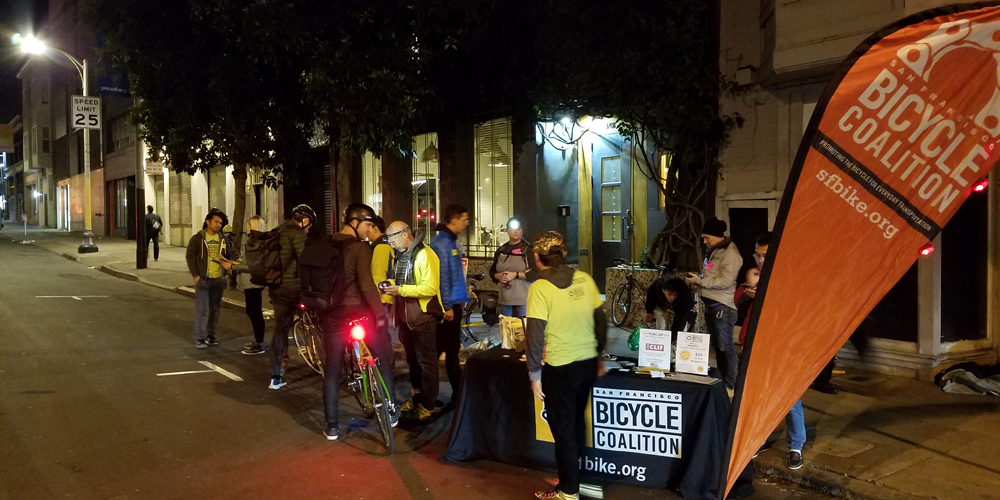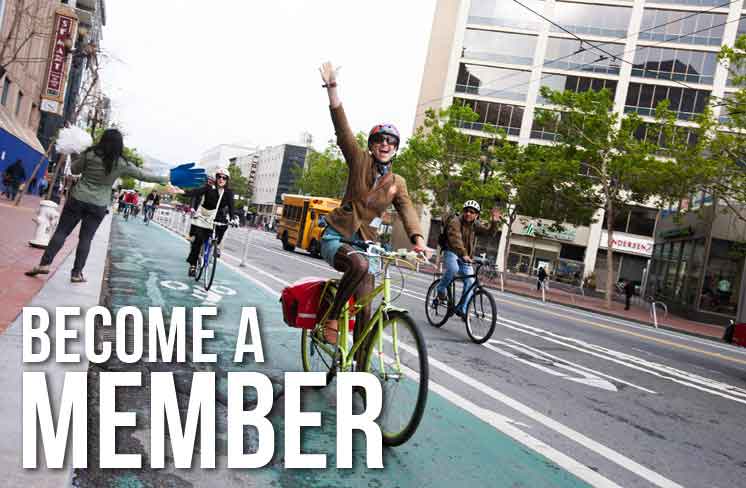Editors: This story was originally published in Issue 162 of our quarterly Tube Times magazine, one of many perks of membership in the San Francisco Bicycle Coalition.
The San Francisco Bicycle Coalition has a new class, Night and All-Weather Biking. Here’s a taste!
Years ago, I left a meet-up with a friend in the Mission. We could see our breath in the crisp January air, and a sliver of moon hung over us. My friend swung her leg over her saddle.
“Where are your bike lights?” I asked, frowning.
She shrugged. “Somewhere in my apartment. But all the streets are so lit up.”
“Gurl!”
“I know,” she said, rolling her eyes.
Yes, we can easily convince ourselves that bike lights on urban streets are redundant. But even if you can see perfectly well (or so you think), most people on bikes realize our lights help others see us even more than they help us see. Although many streets in SF are well lit, conditions change quickly from block to block. And at night many artificial light sources compete for drivers’ attention, so you need to stand out. On well-lit streets, or at dusk, use your lights in flashing mode — the better to attract the attention of people in cars. But on darker streets, use a solid beam; it’s easier for others to judge your distance and motion if your light is the only thing visible.
It’s also the law in California that, at night, bikes must be equipped with at least one front white headlight and one red rear reflector. Without those, police could pull you over. Traffic fines for people on bikes can be hefty, but this one is easily avoidable. Of course, we recommend going beyond the minimum required by law. At the very least, a red rear light will keep you visible to drivers overtaking you from behind.
Aside from the law, lights give important protection even on well-lit streets. In even slightly reduced light, a person’s peripheral vision decreases significantly. Because people on bikes generally ride to the right on streets (keeping outside the door zone, of course), we depend on the peripheral vision of people in cars. Your lights help you overcome their compromised vision.
When should you turn on your lights, though? Many people assume full darkness is the signal, but particularly in winter, when the sun is low in the sky for much of the late afternoon, we recommend turning lights on when we reach “the squinting hour.” This is when the sun is low enough in the sky that people might squint from the sun’s glare. Lights in flashing mode can cut through the blinding glare, improving your visibility to drivers.
Need more reasons to use lights while riding? Several weeks after my evening ride with my bike-light-less friend, I saw her again. She had recently had a minor collision with someone driving on Valencia. The distracted driver had been fumbling with her wallet while pulling out of a driveway and had clipped my friend. My friend was okay but still called the police in case damage to her bike or body crept up later. When the police arrived, they assessed the scene and found my friend at fault, simply because she had no bike lights after dark.
Now that we are far past daylight savings time, be sure to keep those bike lights handy, with an extra set nearby in case batteries lose their charge. Let’s keep our evening streets safe and illuminated.
Get more tips for biking after dark or in wet weather by signing up for our free Night and All-Weather Biking class! Visit sfbike.org/education.
The Tube Times is published quarterly as one of the many benefits to members of the SF Bicycle Coalition. For a complete list of membership benefits, or to join/renew today, click here.


